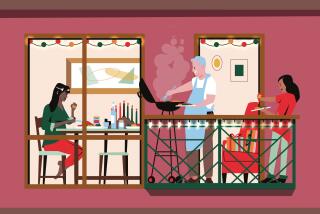BITES : Cream Update
- Share via
After the Aug. 9 death of Grateful Dead guitarist Jerry Garcia, Ben & Jerry’s announced that the company would donate 50 cents to the Dead-favored charity for every cup or cone of Cherry Garcia flavor ice cream sold until Garcia’s burial. The question of his interment is still up in the air so there are no figures yet on the charitable collection, or even on wheither the sales have risen. “We’ve had our hands full,” says Ben & Jerry’s spokesman Sean Greenwood. “It was a blow to folks up here.”
Cook Like a Poet
We know poets starve, but do they cook? Yes, to judge from “The Starving Poets’ Cookbook,” edited by Ron Offen (Free Lunch Arts Alliance; 65 pp.).
This slim paperback gives recipes from 30 poets, accompanied by more or less related poems. The recipes look quite doable (no distillation of moonbeam or even eye of newt; the starving stick mostly to supermarket ingredients), though probably nobody on earth would buy this as a cookbook. They’re a very personal mix of ethnic dishes garret Americana such as oatmeal cooked with trail mix and Burgundy.
This book won’t put Paul Prudhomme out of business, but it gives a far more personal slant (or vast range of slants, poets being poets) on dishes and their place in a person’s life than you’ll find in the sort of cookbook that can, for instance, afford to include photos. For a copy of “The Starving Poets’ Cookbook,” send a $10 check to Free Lunch, P.O. Box 7647, Laguna Niguel, Calif. 92607-7647.
Dancing Goats
On July 15, a hundred or so people drifted around the Romanesque-style WPA structure that once served as the Fullerton library, slurping up espresso and crunching on biscotti as they wandered. It was the opening night of what the Fullerton Museum Center believes is the first exhibit (at least in this country) totally devoted to coffee: “From Dancing Goats to Voltaire’s Notes: The History, Geography and Technology of Coffee.”
On hand that night was coffee historian Ian Bersten, who retailed a vast amount of peculiar lore about the collection of antique coffee grinders, roasters and brewers, many from his own collection, that fill the exhibit. In his pungent Australian accent, he explained the impressive ingenuity and towering wrongheadedness of Pierre Loysel’s complicated 19th-Century coffee machines that passed the brewed coffee back through the grounds in the hope of making richer coffee. “Absolutely guaranteed to produce a bitter cup,” Bersten commented.
There were several primitive espresso machines from the Forties and a gold-planted Bing Crosby coffee pot from the Fifties. There were Old West coffee roasting devices that looked sort of like anarchists’ bombs with crank handles. (You’d fill them with green beans and set them on your wood-burning range; turning the handle was a job usually fobbed off on children.) The espresso cart where everybody was getting coffee was especially built for the exhibit, and when it’s over will become part of the museum’s collection--instant history.
Altogether, “Dancing Goats” is a fascinating exhibit, but the true quibbler will note that it perpetuates an old myth about the word tip ; namely, that the waiters in 18th Century coffee houses demanded a sort of bribe for good service, and you were supposed to put the money in a box coyly labeled T.I.P, for To Insure Promptness. The truth is much less cynical. Tip is just an old slang term meaning “to give something of value that you don’t have to give.” That’s why a tip can be either a voluntary 15% on top of the bill or a bit of free advice.
“From Dancing Goats to Voltaire’s Notes” runs until Aug. 27; it’s open noon to 4 p.m. Wednesday-Sunday (until 8 p.m. Thursdays). The Fullerton Museum Center is at 301 N. Pomona Ave., Fullerton.
More to Read
Eat your way across L.A.
Get our weekly Tasting Notes newsletter for reviews, news and more.
You may occasionally receive promotional content from the Los Angeles Times.










